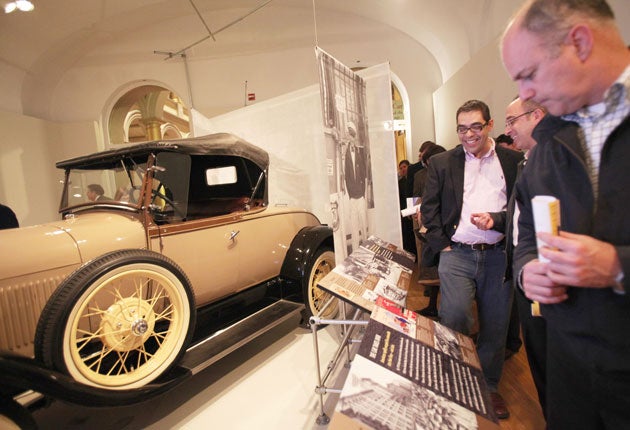Rupert Cornwell: The car park: a celebration of its place in history
Out of America: A new exhibition examining the evolution of the humble garage proves surprisingly enthralling

With its eight gigantic Corinthian columns, its airy arcaded galleries and its football field dimensions, the great hall of the National Building Museum, here in Washington DC, must be one of the most spectacular interiors on earth. Just one amenity is lacking; a parking garage. But right now the museum is making up for that omission. Not by installing one, but by mounting an exhibition about parking garages – those unsung buildings without which urban life in this utterly car-dependent society would turn into apocalypse by gridlock.
I hear your sighs of disbelief. What lends itself less to an exhibition than, as the museum refers to it, "the relationship between the parked car and the places where we live work and play?" In fact, the show is enthralling. The story of the parking garage is a parallel history of urban America.
The first generation, back in the early 1900s, were mostly converted stables, as the motor vehicle began to supplant the horse as the prime mode of transport in America's cities (not before time given that, according to some zealous statistician of the era, horses were by 1880 depositing 4,000,000 lbs of manure and 14,000 gallons of urine on the streets of New York every day).
The exhibition charts the subsequent milestones. The first underground city car park came in the 1920s, in Pittsburgh. But open-sided multi-storey garages did not take hold until the late 1940s and 1950s, when cars were sturdy enough to withstand exposure to the elements. Along the way, there were some notable inventions. You probably imagined the term "double helix" was invented to describe the two-strand structure of DNA, jointly discovered by Francis Crick in 1953. If so, you would be wrong. The first double-helix parking garages, where cars ascend on one spiral ramp and descend on another, so that they never meet, saw the light of day in Richmond Virginia, a quarter century earlier.
Vast numbers of fine buildings were ripped down to accommodate these structures, but a few parking garages are becoming what railway stations used to be: places you might want to have a look at in their own right. The car and the plane have all but destroyed rail travel in the US; here, the renaissance of the railway station evident in Europe, has yet to happen.
But, as the exhibit shows, the humble parking garage is acquiring something of a pedigree. Celebrated architects like I M Pei, Eero Saarinen and Frank Lloyd Wright have turned their hands to them. The latest attraction in trendy South Beach Miami is a new 300-car garage on Lincoln Road, designed by the swanky Swiss firm of Herzog & de Meuron, responsible for – among other things – the Tate Modern in London, and the "Birds Nest" Olympic stadium in Beijing.
The floors of the open-sided, 125ft-high building are concrete slabs, supported by tilting concrete pillars. It features shops and restaurants on the ground floor and a penthouse with terrific ocean views on top, prompting one critic to rave about this "soaring, angular hi-tech testament to form following function".
But South Beach is not alone. At the Texas Medical Center in Houston, the main parking garage's front is formed by a delicate waterfall cascading from the top deck. Other garages now employ "wind veils", facades that move like a field of metallic grass, to conceal the cars within.
But in truth, such fancy establishments are nothing new. When cars were a novelty, so were parking garages. The term motel was conceived not for humans but for cars, as in the Motor Hotel built in Denver in the 1930s. The exhibition features garages that had attendants like soldiers in dress uniform, and others with special levels for women. Washington's own contribution to the history of the parking garage was the 1951 "Parkomat", a narrow multi-storey garage manned by a single attendant, where you dropped your car off at ground level, and a series of hoists and rails lifted it to a vacant spot. "Parking or returning your car takes just 50 seconds," gushed the newsreels.
In those years of innocence, parking garages could still be things of wonder – not dark and spooky places of echoing footsteps, beloved of every director of thriller movies. Now they are a commonplace, but still a crucial part of city planning. Imagine if they did not exist. America already has enough disembowelled small towns, whose most economical use of land is the parking lot. Without the parking garage, either above or below ground, American cities would go the same way, transformed into endless expanses of tarmac, from which buildings rise like lonely islands.
The inner-city parking lot is of course still with us. Take Detroit (which has a thing or two to answer for when it comes to car-choked urban life). I remember how it ripped down the former downtown headquarters of Tamla Motown, turning the site into a parking lot for the 2006 Super Bowl. Could any deed more unmistakably symbolise the downfall of a city?
Even sadder is the tale of the former Michigan Theater. Once it was the biggest, glitziest movie house in Detroit, built in French renaissance style with columns and inlaid ceilings. Now the half-derelict building is a parking garage, perhaps the most beautiful, and certainly the saddest in the country. This monument to decay stands on the site of the tiny workshop where back in 1896 a young engineer at the Edison Illuminating Company built his first car, whose successors would fill parking garages throughout the land. His name was Henry Ford.

Join our commenting forum
Join thought-provoking conversations, follow other Independent readers and see their replies